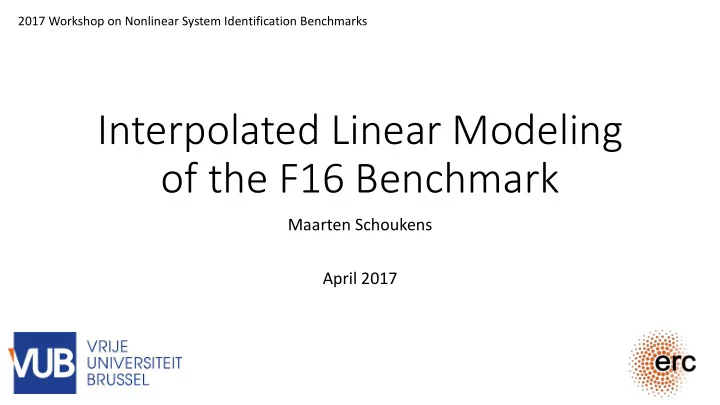

2017 Workshop on Nonlinear System Identification Benchmarks Interpolated Linear Modeling of the F16 Benchmark Maarten Schoukens April 2017
Overview Global vs Local Nonlinear Behavior Interpolated Linear Modeling F16 Results
Best Linear Approximation
Best Linear Approximation y s (t): non-coherent nonlinear contributions n y (t): output noise source
Best Linear Approximation Only valid for a fixed input signal class Input class changes BLA can change
BLA: Shifting Resonances Increasing Amplitude: Shifting Resonances
Global vs Local Nonlinear Behavior ‘Local’ Nonlinear Behavior Shifting BLA ‘Global’ Nonlinear Behavior Model ‘Global’ Nonlinear Behavior using interpolated LTI models
F16 Benchmark Data Multisine Data – Force to Acceleration Payload Frequency Range: 2-15 Hz 4 Estimation Amplitudes 3 Validation Amplitudes RMS: [12 24 36 61 74 86 98] N rms
LTI Estimation
LTI Estimation s-domain (continuous time) 12 poles, 12 zeros Start with lowest amplitude, initialize all the other based on lowest amplitude estimate.
LTI Estimation
LTI Estimation
Interpolation Linear interpolation of the numerator and denominator coefficients Other choices possible: Interpolation of the pole & zero locations Interpolation of the pole-residue representation
Results Interpolated model vs Model estimated on validation data
Results: 24 N rms
Results: 61 N rms
Results: 86 N rms
Results Interpolated model vs Model estimated on estimation data: lower level
Results: 24 N rms
Results: 61 N rms
Results: 86 N rms
Results 24 N rms 61 N rms 86 N rms Estimated 0.098 N rms 0.216 N rms 0.254 N rms Interpolated 0.103 N rms 0.338 N rms 0.263 N rms Level Lower 0.352 N rms 0.823 N rms 0.307 N rms Level Higher 0.262 N rms 0.287 N rms 0.330 N rms RMS error in excited frequency range
Results 24 N rms 61 N rms 86 N rms Estimated 15,2 % 18,5 % 17,3 % Interpolated 16,0 % 29,0 % 17,9 % Level Lower 55,0 % 70,6 % 20,9 % Level Higher 40,9 % 24,6 % 22,4 % Relative error in excited frequency range
Conclusion Global Nonlinear Behavior Interpolated LTI Models Good F16-Benchmark Results
2017 Workshop on Nonlinear System Identification Benchmarks Interpolated Linear Modeling of the F16 Benchmark Maarten Schoukens April 2017
Recommend
More recommend